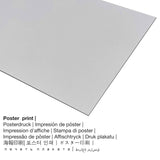Frank Millet, 1884 - A Cosey Corner - fine art print
Tax included. Shipping calculated at checkout.
Product explanation
This modern art work of art "A Cosey Corner" was created by the male painter Frank Millet. The 130 year-old version of the artwork has the size 36 1/4 x 24 1/4 in (92,1 x 61,6 cm) and was crafted with the medium oil on canvas. Nowadays, the piece of art belongs to the The Metropolitan Museum of Art's art collection, which is located in New York City, New York, United States of America. With courtesy of - The Metropolitan Museum of Art, New York, Gift of George I. Seney, 1887 (public domain license). Creditline of the artwork: Gift of George I. Seney, 1887. Moreover, alignment of the digital reproduction is in portrait format with a side ratio of 2 : 3, which implies that the length is 33% shorter than the width.
Select your material option
For every product we offer a range of different materials and sizes. Choose among the following product options now to match your preferences in size and material:
- Printed poster (canvas material): Our poster print is a printed sheet of canvas paper with a fine texture on the surface, which reminds the original masterpiece. The printed poster is best designed for framing your art print in a custom-made frame. Please bear in mind, that depending on the size of the canvas poster print we add a white margin between 2-6 cm round about the painting to facilitate the framing with your custom frame.
- Aluminium print (aluminium dibond): These are metal prints on aluminium dibond with an impressive effect of depth. For the Direct Aluminium Dibond print, we print the favorite artpiece on the surface of the aluminum composite. This UV print on aluminium is one of the most demanded entry-level products and is a truly modern way to showcase art prints, since it puts all of the viewer’s attention on the image.
- Printed acrylic glass (with real glass coating): A glossy acrylic glass print, often referenced as a UV print on plexiglass, changes the original artwork into lovely décor. The work of art is custom-made thanks to modern UV direct print machines. This makes vivid and sharp color shades. The great upside of an acrylic glass fine art print is that contrasts as well as image details will be more exposed due to the subtle gradation. The acrylic glass protects your custom fine art print against light and external influences for many years.
- Canvas print: The printed canvas, which should not be mistaken with a painting on a canvas, is a digital replica printed directly on cotton canvas. A canvas of this artwork will allow you to transform your very own fine art print into a large artpiece as you know from galleries. Hanging your canvas print: The great advantage of canvas prints is that they are relatively low in weight. This means, it is quite simple to hang the Canvas print without the use of additional wall-mounts. A canvas print is suited for all types of walls in your house.
Important legal note: We try whatever we can to describe our art products as closely as possible and to display them visually on the various product detail pages. At the same time, the pigments of the print products, as well as the print result may vary slightly from the image on your device's screen. Depending on the settings of your screen and the quality of the surface, not all color pigments can be printed 100% realistically. In view of the fact that all fine art prints are processed and printed manually, there might also be minor deviations in the motif's size and exact position.
The product
| Product categorization: | art reproduction |
| Reproduction method: | reproduction in digital format |
| Manufacturing method: | digital printing (UV direct print) |
| Product Origin: | Germany |
| Stock type: | on demand |
| Proposed product use: | art reproduction gallery, wall gallery |
| Image alignment: | portrait alignment |
| Image aspect ratio: | 2 : 3 |
| Aspect ratio meaning: | the length is 33% shorter than the width |
| Available reproduction fabrics: | metal print (aluminium dibond), poster print (canvas paper), canvas print, acrylic glass print (with real glass coating) |
| Canvas print (canvas on stretcher frame) sizes: | 20x30cm - 8x12", 40x60cm - 16x24", 60x90cm - 24x35", 80x120cm - 31x47", 100x150cm - 39x59" |
| Acrylic glass print (with real glass coating) size variants: | 20x30cm - 8x12", 40x60cm - 16x24", 60x90cm - 24x35", 80x120cm - 31x47", 100x150cm - 39x59" |
| Poster print (canvas paper) size options: | 40x60cm - 16x24", 60x90cm - 24x35", 80x120cm - 31x47" |
| Aluminium print size options: | 20x30cm - 8x12", 40x60cm - 16x24", 60x90cm - 24x35", 80x120cm - 31x47" |
| Picture frame: | please bear in mind that this art print does not have a frame |
Artwork details
| Artpiece name: | "A Cosey Corner" |
| Artwork categorization: | painting |
| Broad category: | modern art |
| Artwork century: | 19th century |
| Artpiece year: | 1884 |
| Artwork age: | over 130 years |
| Medium of original artwork: | oil on canvas |
| Original size: | 36 1/4 x 24 1/4 in (92,1 x 61,6 cm) |
| Museum / collection: | The Metropolitan Museum of Art |
| Museum location: | New York City, New York, United States of America |
| Museum's website: | The Metropolitan Museum of Art |
| License type: | public domain |
| Courtesy of: | The Metropolitan Museum of Art, New York, Gift of George I. Seney, 1887 |
| Creditline: | Gift of George I. Seney, 1887 |
General information on the artist
| Artist name: | Frank Millet |
| Artist gender: | male |
| Jobs of the artist: | painter |
| Classification: | modern artist |
| Life span: | 66 years |
| Born in the year: | 1846 |
| Year died: | 1912 |
© Copyright of - Artprinta.com (Artprinta)
Original artwork information from The Metropolitan Museum of Art (© - The Metropolitan Museum of Art - www.metmuseum.org)
Millet, who specialized in American and English costume genre paintings, first visited Broadway, the picturesque Cotswolds village, in 1884. His home and studio there would become the center of an Anglo-American artists colony to which John Singer Sargent and Henry James were frequent visitors. The costume of the figure reading in "A Cosey Corner" is a romantic re-creation of several different English eighteenth-century fashions, and the interior architecture also seems English. Several features of the room, however, correspond to a published description of the colonial New England kitchen in Millet's East Bridgewater, Massachusetts, studio. Later in his life, Millet was active in many arts organizations, including the American Academy in Rome. Returning to New York on academy business, Millet went down on the Titanic.














